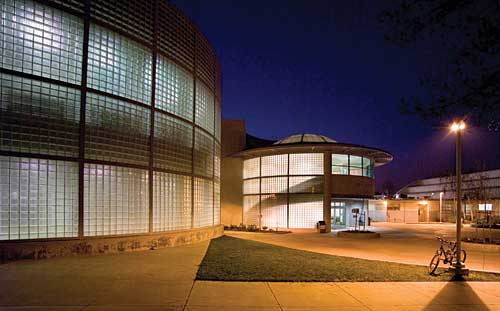Designing With Glass Block: Abundant Applications Provide Practical, Aesthetic and Green Solutions
Panel anchoring. Three methods for anchoring glass block panels are recommended to accommodate lateral support along the top and sides of each panel - panel anchor, channel, and chase systems. These supports are designed to resist the applied loads, or a minimum of 200 pounds per lineal foot of panel, whichever is greater.
Panel anchors: Available in stainless steel or hot-dipped galvanized steel, panel anchors tie glass block panels into the surrounding frame at head and jamb locations. Anchors are used along the jambs and at the head, or they can be used in combinations with channel construction where one type of detailing is at the jambs and the other at the head. Anchors are normally placed a maximum of every 16 inches on center. This means that for an 8 x 8-inch block, panel anchors would be placed in every other course.
Channel framing: Either a metal channel or metal angles combined to form a channel can be used. The channel opening (for a nominal 4-inch-thick block) must be 4-1/4 inches to 4-1/2 inches wide by a minimum of 1-3/8 inches deep to allow for a 1-inch minimum recess of glass block into the channel and for placement of the expansion material inside the channel. It is critical that the channel opening be square, not tapered as in standard channels, so as not to pinch the edges of the glass block. The oversized opening allows the insertion of packing material and sealant between the recessed faces of the glass block and channel legs.
Chase method: A recessed chase can be inserted into concrete or masonry jambs and head, eliminating the need for anchors or metal channels. The dimensions described must be similar to those described above for metal channels.
Â
Â
|
Â
Expansion joints. To accommodate movement of the glass, expansion strips 3/8-inch thick, are required along the top and sides of glass block panels. These joints are filled with a resilient material such as polyethylene, which allows the panel to expand and contract. In exterior walls, joints must be well caulked to prevent water penetration.
At the bottom of the opening, a water-based asphalt emulsion is placed on the sill prior to laying the first mortar bed. This provides a slip plane for the panel and also prevents water from being drawn out of the glass block mortar by absorbent sill materials, such as concrete, brick, wood, or other porous products.
Curved walls. Curved panels require additional structural support where the curved section joins a straight section and at inflection points in multi-curved walls. One method is to connect the panel to a structural member with panel anchors. Installing a steel plate in a vertical head joint can provide a less visible support. Also, panel reinforcing should be modified to follow the contour of the curve by periodically cutting the innermost parallel wire and bending appropriately.
The inside minimum radius of a curved wall is influenced by the size of block being used. Creating a tighter curve means creating a thinner inside joint, which is not recommended, and a thicker outside joint, which may not be aesthetically pleasing.
Health, Saftey and Environmental Benefits
The unique properties of glass block are especially applicable to health and safety issues, in addition to providing a number of environmental advantages. They offer special performance characteristics regarding fire resistance; resistance to surface condensation, light, heat, thermal and shading performance; sound transmission; and hurricane and earthquake resistance. Equally significant is the potential role in green building and contribution to several categories in LEED certifications-both in quantifiable and qualitative measures.
Green building now includes far more than data and performance of building products. Occupants' comfort and well-being and factors such as daylight are critically important for Green Building-especially when designing for the unique needs of children of all ages. Another factor in Green Building is life cycle analysis, which quantifies the impact of a product or building from raw materials used through its disposal or reuse. While life cycle analysis is, as yet, hard to quantify, it is certainly an issue to consider when specifyng green products. Glass block has the advantage of having a relatively low life cycle impact, being both recyclable and manufactured from unlimited natural resources. Moreover, being 100 percent glass, it does not emit any harmful volatile organic compounds (VOCs).
Â










